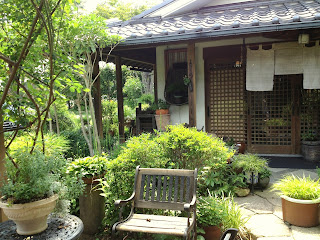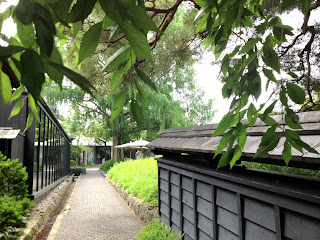>>春日大社本殿 – Kasuga Taisya ☆☆☆☆☆
鹿を神使とする春日大社にも、もちろん鹿はたくさん。
手水場にまで鹿でした。(咥えている巻物らしきものから手水が!)
日本の歴史における名門 藤原氏の氏神:春日神(主祭神の4柱の総称)を祭ってある背景なぞ知らず、鹿とたわむれつつ、「なんで馬鹿って、馬と鹿なのー?馬も鹿も賢いよね」とおバカな話をしながら、本殿へお参り。
「神主・巫女のガイド付き特別参拝」や、「神主が案内する朝のお参り」もあるそうです。
In Shinto, an animal is specified
as a messenger servant of god and a deer is the one for Kasuga Taisya. We see a lot of deer and found the water to
wash our hands & mouth for purification comes from the statue of deer.
We did not know about the
history of the Kasuga Taisya at all and talked rubbish watching closely a flock
of deer on the approach to the main shrine.
“BAKA” means a fool; “馬鹿” in Kanji(Chinese character) and it consists of 馬(horse) & 鹿(deer). We do not understand it because a horse and deer is clever,
right?
They offer visitors unique
occasions like “Special guide by a Shinto
priest
& Miko; shrine maiden”.
>>宝物殿 – The treasure house ☆☆☆
宝物殿で特別公開中の「華やかな屏風と祭礼図」に立ち寄り。
点数は多くないし、こぢんまりとしてましたが、これが、なかなかの面白さ。
絵巻が特に面白かった。
後世に名を残したような有名な絵師によるものではないのだろうけど
万葉のおおらかさが生き生きと細かく描かれていて
自分の祖先からのタイムカプセルを開けたら出てきた宝物のような気がしたのです。
絵の中にちらほら発見 -昔からお調子者っていたのですわね。
館内でアブに足をさされて、ちくちく痛かったので-☆。
We dropped by at the shrine
treasure house where a special exhibition was held to show their valuable folding
screes and ritual paintings.
It was a small exhibition but
we enjoyed more than expected.
We especially liked picture
scrolls by no-name painters in ancient time.
They described vividly broad-minded
culture at that time and it’s like we found a time capsule and saw the
treasures from our ancestors in it.
We laughed when we found
several guys looking “easily flattered” on those pictures.
As a horsefly bit my leg in
the house, let me reduce a ☆.
>> 若宮神社、夫婦大國社 – Wakamiya Jinja & Meoto Daikokusya ☆☆☆☆☆
我ら木漏れ日愛好家にとって、春日大社内はハイキングに最高ではないですか!
涼しくて、あー、爽やか。
途中で勝手にご神木にした巨木に出会ったり。
(幹からにょきにょき生えているものは「枝」と呼ぶようなものではなくまさに「幹」)
We are “Sunshine through
leaves” lovers and found Kasuga Taisha is the best place for hiking.
It’s cool with fresh air in
the forest.
We met a huge tree and we decided to call it as a sacred tree on our way to the next destination.
若宮神社は、さっき宝物殿でいくつかその名を目にしたばかりなので
またまた万葉の風に吹かれた気分に。
That’s because we saw the
names of Wakamatsu Jinja at the treasury house just several minutes ago, we
felt as if we stood in the wind from ancient time again in front of the shrine.
夫婦大國社では“しゃもじ”を奉納してきました。
こちらの神社は大国主命(おおくにぬしのみこと)と須勢理姫命(すせりひめのみこと)の夫婦神がご祭神。
なぜ、“しゃもじ”か?
古事記によれば、大国主命さまは、結婚する前は兄たちにいじめられて、というか、確か2度殺されて(&復活)、スセリヒメのお父さんスサノオノミコトにも4度殺されそうになり、
ヒメとネズミのおかげで危機を切り抜け、いつの間にかモテモテなイケメンにおなりになったお方。
大国主命さまは既に八上比売(ヤカミヒメ)と結婚してお子もいたけど、ヤカミヒメはスセリヒメが怖くて実家に帰ってしまったそうです。
やれやれ、神様の世界もいろいろ大変ですな。
小学2年生の時に“因幡の白ウサギ“でウサギ役をやって以来、どうやら大国主命さま(大黒天さま)は私の守護神のようです。
Real sacred tree 本当の御神木
Deities of the Meoto
Daikokusya are married couple; Ookuninushi-no-mikoto & Suseri-hime-no-
mikoto. I dedicated a Shamoji(rice scoop) to the shrine.
Why “Shamoji”? – Because they
said Suseri-hime had it.
Ookuninushi is one of the
most famous divine beings in Japan and has a lot of famous myths.
For briefing, please refer to
the blow.
*They said Ookuninushi has not
a few love stories. Yakami-hime who got
married with him first run away as she was afraid of Suseri-hime…
Japanese Shinto gods have a
same kind of drama like us.
By the way, I played the role
of a rabbit in the famous myth “Hare of Inaba” in which Ookuninushi saved me
when I was in the 2nd grade at elementary school. So I believe he is special to me.
>>参道にて – the approach to the main shrine ☆☆☆☆
「もみじの花が咲いてるよ」と、唐突に参道の傍らに座っていたご老人が指差して教えてくれました。
おー!竹とんぼみたいな花(?)が青いもみじの葉と一緒にたくさん!
雲一つない空に緑と赤色が映えて美しい。
まあ、種っていううわさもあるけど、仙人のお言葉はありがたくいただいておこう。
バンビが年代物の灯篭の間からこっちを覗いてたり、
お店のおばちゃんが居ぬ間に鹿せんべいをねらう一群やら
参道も結構スペクタクルで楽しかった。
An old man suddenly told us
pointing at leaves, “Maple tree blossoms”
See? We found many flowers (?) like bamboo
copters!
Yes, they were NOT flowers
but seeds. But we appreciated his words
as he must be a holly being like mountain hermit.
It’s so beautiful with green
leaves, red seeds and the blue sky behind.
We also met a lovely Bambi
looking toward us through the space between stone lanterns.
It’s so funny to look a gang
of deer tried to sneak rice (?) crackers while a shopkeeper was away and soon
the old lady noticed and scared them off using a broom – Actually, they were
not scared at all. You can see many small shops where crackers are sold for
feeding the deer everywhere in town.














































